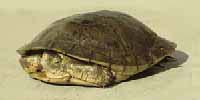Why Did the Turtle Cross the Road? Tony Hacking Page 2
However, if you
really want to get a good look at WPTs, the best time is when they are
basking in the sun. Pond turtles, being reptiles, are “cold-blooded” and
need to warm up after a morning spent scouring underwater substrates for
tasty morsels. They do this by lying just below the surface on floating
mats of vegetation, but often crawl out on emergent logs (they prefer the
ones that aren’t attached to the shore, so that terrestrial predators can
not easily reach them). The trick if you want to get a good look at them
though, is to sneak up on them and use optics such as binoculars and/or a
spotting scope. Otherwise, they can see or hear you from a long way off,
and will disappear under the water. “Lake” Oogaromtok (otherwise known as
the Frog Pond) near the mouth of Rock Creek is a good place to see them
basking on a sunny spring morning, as is McGain’s (Prichard’s) Pond just
outside of Orleans.

So what causes turtles to wander away
from water where you may see them crossing a road? They are extremely
vulnerable when doing this. There are at least four possible reasons:
1. Pregnant females lay their eggs on land requiring
them to leave their aquatic
environment in May and June.
2.
Leaving aquatic environments prior to the flooding of winter to their
overwintering site (often in September & October).
3. Returning back to aquatic environments from their overwintering site (March and April).
4. Exploring for new habitat
If you happen to pick up a wandering turtle, look at the underside (the plastron). If it is flat, the turtle is a female. If it is May or June the turtle is likely female and gravid or with eggs, and is heading for a river terrace, back to the same place she was born. Typically, sparsely vegetated area with good solar exposure to dig a hole in the shape of an upside down light bulb and deposit her eggs (8-12). It is important that she is not disturbed during this period. By all means don’t think she needs to be headed back towards water, as turtles have been known to nest up to a quarter mile away from water.
If the underside is concave, the turtle is a male. He may either be exploring for a new, less crowded home (which is how remote ponds get colonized), or he is seeking out or returning from his upland over-wintering site. Both sexes occasionally explore, and every fall, they leave the water and return to their exact overwintering site, nestled under the duff to await the spring. Many of the details of western pond turtle nesting and over-wintering are poorly understood. The best thing you can do for a turtle crossing the road (as with other things), is leave it be!